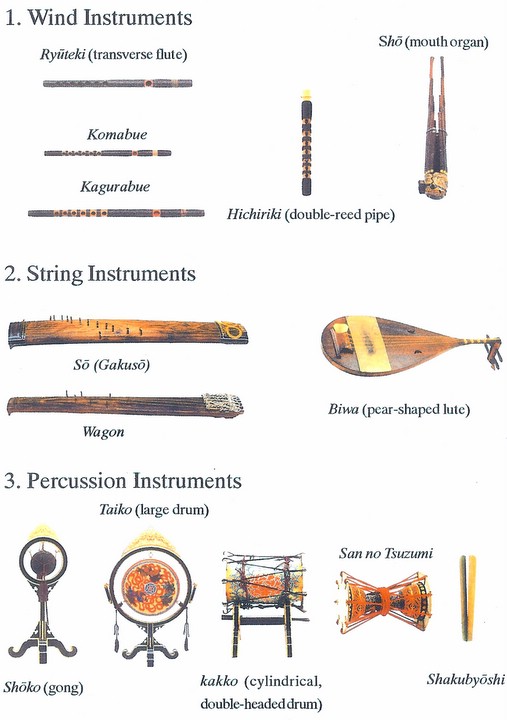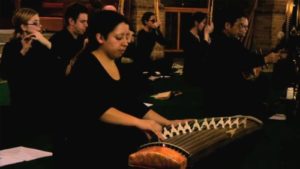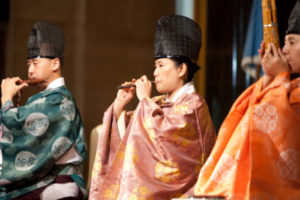Greetings to Members and Friends
This year has been full of activity for IMJS. The highly successful Women and Buddhism Workshop, held in New York in 1989, spawned various other projects, including the panel “Women in Japanese Buddhism: An Interdisciplinary Approach” held at the 1990 AAR meeting (see panel report on page 5), the panel “Childbirth, Child-death, and Poetic Transcendence: Creative Coping in Pre-Modern Japan” for the 1991 AAR Mid-Atlantic Regional Conference and the 1991 Annual Meeting of the AAS (see details on page 8), as well as plans for a translation volume and a research volume now in progress.
We also sent Anne Lazrove to attend the summer seminar of Kenkyukai: Josei to Bukkyo in Japan in August, and her report follows.
The study of women in ancient and medieval Japanese society lags behind the study of women in the ancient Mediterranean world or medieval Europe. Interest is quickening, however, and Japanese women are gradually being brought out of the historical shadows. Until recently, literary studies have been most advanced; with considerable attention given to the literary activities of Heian court ladies. Art historians have begun to look at the role of women as patrons of art and the ways in which they are represented in art. The role of women in Buddhism is beginning to receive systematic attention, opening the way to a broader study of the spiritual lives of women. These studies are now converging and stimulating interest in the social history of women in ancient and medieval Japan.
We hope this report will facilitate further research activity and that we will hear from those of you who wish to join the network in the exchange of research and curricular information to advance this new field.
Kenkyukai Nihon no Josei to Bukkyo Summer Seminar
by Anne Lazrove
Due to the generous support of the Institute for Medieval Japanese Studies at Columbia University, I was able to attend the 7th annual meeting of the Kenkyukai Nihon no Josei to Bukkyo from August 26-28. This year the conference was held in the village of Togakushi in the mountains north of Nagano City.
As most of you know, the Kenkyukai Nihon no Josei to Bukkyo is a loose association of scholars from all over Japan which meets every year in the summer to present papers and discuss topics related to women and Buddhism. Although there is no formal register of members, the number of participants has been consistently around fifty. The official leader of the group is Osumi Kazuo, Professor of Medieval Japanese History, Tokyo Women’s University. Many of you will remember Professor Osumi and other core members of the kenkyukai, seven of whom attended the workshop in New York last December.
There were seven speakers at this year’s conference. I began by presenting a report on the various projects related to women and Buddhism sponsored by the IMJS. These included last year’s workshop, the translation project and the panels planned for this year’s annual meetings of the AAS and AAR. During the question and answer period, I was asked the extent to which the interest in this field among American scholars is a reflection of recent trends in Japan.
The next speaker was Paula Arai a Ph.D. candidate in comparative religion at Harvard University, who had just completed a year of dissertation research in Japan on a Fulbright grant. Ms. Arai is conducting a sociologic survey of contemporary Buddhist nuns, especially those of the Soto school. She is concerned with all aspects of their lives their daily activities, status within the Buddhist community, organizational hierarchy, age and social background, and so on. In addition, she has spent time at a training institute for nuns, participating in their daily regimen. Ms. Arai gave a summary of her findings which also have been published in English in the most recent issue of the Nanzan Bulletin (14).
Ushiyama Yoshiyuki Professor of Medieval Japanese History, Shinshu University and organizer of this year’s seminar, presented a paper on the history of the Zenkoji temple in Nagano City. He began by pointing out that, although many essays have been written on the history of this temple, they have been largely based on the Zenkyoji engi, the traditional legendary history maintained by the temple. Most previous research has focused on Zenkoji as a center of popular devotion and folk-religious practices. Professor Ushiyama’s object was to reinterpret the historical role and status of this temple by examining a wider variety of sources. Archaeological evidence shows that the first temple on this site was probably constructed m the 7th century and shows a strong Korean influence. The subsequent history of the temple can be pieced together from accounts in the six national histories, the Azuma kagami, court diaries and other sources. Under the ritsuryo system, the temple played a role in the local government which had its headquarters nearby. Zenkoji was the uji-dera (clan temple) of the Kanazashi clan whose members, both male and female, served political roles in local government as gun officials. Thus this temple became well-known in the Japanese capital despite its great distance from Kyoto. In the Nara and Heian periods, Zenkoji was given the high status of jogaku ji-in under the system of government sponsored temples. Its relative importance within the sectarian establishment of the Tendai school of Buddhism also can be inferred from the fact that an abbot of the Onjoji temple (one of the two headquarters of the Tendai establishment served as betto. Professor Ushiyama went on to speak about the importance of the temple to women, both as a pilgrimage site and later, as the site of a major convent where women lived and practiced.
The next speaker, Abe Yasuo, is Professor of Medieval Japanese Literature at Otemae Women’s University in Kobe. Professor Abe has a particular interest in legends associated with the early patron of Buddhism in Japan, Shotoku Taishi. At this conference he gave a talk on the relationship between the pictures and the text of the Shigisan engi emaki, the medieval picture scrolls depicting the miracles on Mt. Shigi. His main object was to show how these two forms of expression complement each other by revealing different aspects of the story. Professor Abe illustrated his point using examples from the Amagimi no maki – or the so called “Nun’s scroll” – the section he considers most crucial for understanding the tale as a whole. Ostensibly the section is about the origin of the omamori or talismans given out to the pilgrims to Mt. Shigi. Woven into the pictures, however, is the theme of eros and sexuality. Male and female symbols are hidden in the forms of rocks in the illustration of the nun questioning the old man at the crossroads. The text states that the nun is looking for her brother, but the illustration shows that it is also the final consummation of the male and female opposites (in and yo) that is being sought. In the picture of the nun in front of the Buddha at Todaiji, we see that she is actually inside the hall, a space normally off-limits to women. The fact that she broke through the barrier of sexual duality made it possible for the Buddha to speak to her. These were among the examples that Professor Abe used to show how the emaki, through the dual media of words and visual art, encompasses multiple dimensions of human experience.
Osumi Kazuo spoke about the image of women’s religiosity found in the medieval priest Muju Ichien’s collection of setsuwa tales, Shasekishu. Women figure in the tales in three ways. They are frequently possessed by evil spirits which need to be exorcised, they are particularly devout in their faith, and they sometimes appear as the caretakers of monks or male members of their family. According to Professor Osumi, although Muju does not show any special interest in women in this collection, neither does he pass judgment on their activities or character. Even in stories which seem to paint an unflattering picture of women, the central female character also possesses some admirable quality. In the story of the woman who did not want the smoke from her incense to touch any statue except the one she was worshipping, the woman is portrayed as sincerely faithful. This particular story reflects the fact that self-centeredness is a trait which often can be found in particularly devout people. Professor Osumi sees the author as an astute and well-balanced observer of human nature rather than a moralist.
Sugawara Masako, who has a part-time appointment at Toho Junior College, compared the Confucian ideal of the chaste woman (Ch. jie fu or Jap. seppu) in China and Japan in order to show that Confucian values did not penetrate Japanese society under the ritsuryo system. Comparing accounts of such women in the Chinese dynastic histories with relevant passages from the Japanese poetry collection Man’yoshu, the ritsuryo codes and the Japanese national histories, she tried to show that there were important differences between the lifestyles of the Chinese and Japanese seppu. In both China and Japan, the term referred to a woman who had lost her husband and chose not to remarry. In China the word was applied to young widows who committed suicide or disfigured themselves in order to avoid remarriage. They were credited with having composed lengthy arguments or poems to explain their actions, which reflected their commitment to Confucian ethics. In Japan, however, the widowed women noted in records were older and often had many children. They lived out their lives in a natural fashion, and some had shamanistic powers. They were women from the upper levels of society whose husbands often had been Government officials; in other words, they would have commanded some authority in their community. Official recognition of their “virtue” meant that their entire village was exempted from certain types of taxation. Ms. Sugawara speculated that this phenomenon represented an attempt 6y the court to exert its influence in the provinces rather than a wide-spread assimilation of Confucian ethics.
The final report was an attempt to identify some of the assumptions that traditionally have impeded scholarship on women and Buddhism. Two younger members of the group, Hayashi Jun, and Mitsuhashi Tadashi, questioned the validity of drawing an unqualified distinction between nuns and laywomen and spoke about the need to distinguish between different types of discrimination. They argued, for example, that discriminatory passages in scripture, or the practice of barring women from holy sites, or again women’s relatively inferior social status represent three very different levels of discrimination which did not always co-exist. “Discrimination” clearly was a sensitive topic and provoked considerable debate afterwards. Several people expressed the opinion that scholars have been overly preoccupied with the emotionally charged issue of discrimination. They felt that the question of whether or not a particular practice or ideology was discriminatory needs to be set aside at some point in order to achieve a more complex analysis of the role of women in Buddhism.
The Kenkyukai Nihon no Josei to Bukkyo will hold its final all-members seminar next summer in Kyoto, after which it plans to abandon its present format, disband the now very large group, and reform into new smaller research cells. The core members of the group feel that, over the past S years, they have accomplished their original aim of identifying the most important philosophic and methodologic issues involved m doing research on women and Buddhism in Japan. During this process, differences in orientation between scholars from different disciplines and fundamental research needs have become apparent. The consensus was that, as the research issues become clarified and more specialized, it is best for such problems to be pursued by individuals or by smaller groups of scholars who share a common interest and orientation rather than to continue to try to function as one large research group. One such newly-seeded group already has been formed by our workshop colleagues Nishiguchi Junko and Katsuura Noriko, who are meeting monthly to read together early and medieval primary sources and to compile data on all such source material pertaining to women and Buddhism in the pre-modern period.
In spite of their decision to dissolve the overall kenkyukai structure, both Professor Osumi and Ms. Nishiguchi, the original organizers, voiced their continued commitment to close contact and cooperation with scholars in the US and other countries, and individual scholars all are committed to oontinuing their own research in the field individually or in smaller local groups throughout the country. Clearly the kenkyukai played a seminal role in nurturing and strengthening scholars’ commitments to the field and giving them the courage and tools to branch out on their own.
AAR Panel Report
“Women in Japanese Buddhism: An Interdisciplinary Approach”
by Indra Levy
On November 19, 1990 at the Annual Meeting of the American Academy of Religions in New Orleans, the IMJS sponsored a panel titled “Women in Japanese Buddhism: An Interdisciplinary Approach.” Paul Groner (University of Virginia organized and presided over the panel
As the first speaker, Groner spoke with enthusiasm of the Women and Buddhism Workshop sponsored by IMJS last December, and the interest it generated in this under-explored field. He emphasized the fact that the workshop embraced a broad, interdisciplinary perspective on the subject of women and Buddhism in pre-modern Japan, an approach which was again employed by the panel at hand.
The first paper-presenter was Martin Collcutt (Princeton University) on the topic of “Hojo Masako: The Nun-Shogun Reevaluated.” With reference to the Gukansho and the Azuma Kagami, Collcutt attempted to debunk the rumors which came to surround Hojo Masako’s career during later periods of history and have persisted into modern times. Although it is commonly held or suspected that Masako was a jealous and vindictive wife to Minamoto Yoritomo and perhaps even had a secret hand in his death, and that she sacrificed her children to her political ambitions, Collcutt’s reference to contemporary sources brought up instances which depict a strong, politically adept woman of a more compassionate nature. Finally he raised the question of the extent to which her nunhood expressed sincere religious interests. Though she became a nun, she did not cloister herself but continued to be active in the political world. Collcutt pointed out that her nunhood was an expression of widowhood, and that it also gave her freedom by putting her above family quarrels, thereby enabling her to advise a consistent plan of action to the Bakufu. Whereas rumors and historical slander have prevented Hojo Masako from becoming an exemplum for women, Collcutt concludes that, as a medieval Japanese woman, she was both unique and representative.
Next, Mimi Yiengpruksawan (Yale University) presented her paper titled, “Taikenmon’in Fujiwara no Tamako: A Case Study in Extended Patronage of Buddhist Art by a 12th Century Royal Consort.” Through a close reading of seven contemporary court diaries, such as Denryaku. Choshuki and Chuyuki, Yiengpruksawan discovered that Taikenmon’in Fujiwara no Tamako (1101 – 1145) had been a prolific, albeit historically overlooked, patron of Buddhist art in the late Heian period. Using statistical charts, Yiengpruksawan showed that Tamako had commissioned hundreds of Buddhist sculptures and at least 31 Buddhist halls and chapels. The Hokongoin Temple was the principle project of her life. Yiengpruksawan posed the question of why Tamako, like many of her peers, was so driven to commission Buddhist art, and tentatively proposed that, “in an economy driven by a desire to get into heaven,” the production of art was one means of accruing merit. It was also a means of displaying power and riches, possible a manifestation of Tamako’s need to stabilize her position at court.
The next speaker was Karen Brock (University of Michigan), who presented her paper titled “An Exemplum for Women: “The Nun’s Scroll’ from Miraculous Origins of Mt. Shigi.” Miraculous Origins of Mt.Shigi is a set of three picture scrolls depicting the legendary powers of Myoren, a tenth century ascetic monk. While the first two scrolls depict Myoren’s miraculous powers, the third scroll, known as ‘The Nun s Scroll’, is devoted to the story of Myoren’s elder sister, a nun who embarks on a long search for her brother. Though many studies have treated the third scroll as the secular portion of Mt. Shigi. Brock considers the possibility that it was created to provide an exemplar of feminine spirituality, noting that the work was produced under the supervision of high ranking sponsors at a time when readers of picture scrolls were primarily court women. She points to the striking depiction of the nun at the Great Buddha Hall of Todaiji, a portion of the scroll which shows, in one scene, five small figures of the nun – arriving, in prayer, asleep and in departure – in front of the statue of the Great Buddha The interior of the Great Buddha Hall was off limits to women, so the exception of the nun depicted there may suggest that women too could attain a degree of spirituality high enough to transcend this prohibition. The narrative also suggests that through her fervent prayer, the nun was able to receive the favor of Buddha’s providence and be led to her brother. In the end, the nun finds her brother in his mountain hermitage, and the scroll shows the two living together, with Myoren studying and teaching his elder sister while she takes care of household duties. Brock points to this as an illustration of the nun’s role in providing material support for the holy man.
Paul Watt (Depauw University), the final paper-presenter, discussed “Body and Society in Jiun’s (1718-1804) Buddhism. Jiun was an 18th century monk who sought a return to what he considered “original Buddhism.” Watt introduces his topic with reference to Peter Brown’s book The Body and Society and with attitudes towards sex in Greco-Roman culture and early Christianity, suggesting that the kinds of sexual prohibitions attending Augustinian Christianity were analogous to developments in Japan with Pure Land Buddhism. Jiun held that, originally, there were no distinctions between men and women, and hence both were capable of Buddhist enlightenment. He describes men as having relatively few attachments or cravings (“shuchaku usuki mono“), and women as being predisposed to having many affections (“aijo oki mono“). But the “pure mind” transcends all dualities, including the “temporary marks” of male and female. Many of Jiun’s sermons were addressed to nuns, but they were often free from gender reference and could as well have been addressed to monks. However, he did prescribe the eight precepts (hachi kyokai) for women: because they were naturally “haughty,” they must acknowledge the superiority of monks. Though Jiun’s doctrine was not free of sexual chauvinism, he did seek to establish the religious equality of men and women.
The final speaker at the panel was discussant Barbara Ruch (Columbia University). She started out by noting that, although not by prior design, all four papers dealt with nuns in some respect, and she raised the problem of scholars tending to make generalizations about nuns at a time when the role of nunhood in pre-modern Japan has not yet been clearly established and still needs to be grappled with. Ruch stressed the diversity of nuns, types of nunhood and attendant status, including commercial nuns, half-time nuns, nun prostitutes, nun-widows, and other varieties. As an area for further research, Ruch suggested an investigation of what nunhood implied for the women discussed in all four papers. She said that Collcutt’s paper raises the important and enigmatic issue of “reputation” in history, and the difficulty of how to debunk a reputation that has become a tradition without becoming an apologist. She commented that Yiengpruksawan’s paper shows what a close reading of primary sources can achieve, and challenges claims that women have been ignored by scholars because of a dearth of source materials: in men’s diaries which are not obscure, Yiengpruksawan discovered the history of a woman which had been quite simply overlooked. Ruch asked if the temples commissioned by Tamako were for public or private use, as well as what a sculptural image meant to Tamako. Why did she choose to commission primarily sculptures rather than paintings or sutras? In response to Brock’s paper, Ruch wished to gain a clearer understanding of the meaning of “The Nun’s Scroll’ as an “exemplum” – specifically, who directed it at whom, and to what aim? She raised the point that the relationship between monks and elder sisters should be further investigated, and cited other examples of monks living with their elder sisters. Ruch also wanted to know more about the Todaiji scene, and the significance of the sudden change from narrative to iconic style which sets it apart from other scenes in the scroll. With regard to Watt’s paper, Ruch questioned his suggestion that “True Land Buddhism is Augustinian,” and whereas Watt had proposed analogies between views of the body in Christianity and Buddhism, Ruch observed some fundamental differences: asceticism for women in Christianity embraces the passion of the body in union with Christ, whereas Buddhist asceticism seeks the complete erasure of passion. She also commented that Jiun’s sermons seem to ignore the role of the biological body in the construction of gender, and instead focus only on the mind. Nor did Jiun consider the cultural aspects of gender. In general Ruch emphasized the important contributions of all four papers to a field which has long been overlooked by the mainstream of academia and still demands further exploration.
UPCOMING EVENTS FOR SPRING 1991
Panel:
“Child-birth, Child-death, and Poetic Transcendence: Creative Coping through Buddhism in Pre-Modern Japan.”
Edward Kamens
“The Five Obstructions (Gosho, Itsutsu no Sawari) as Waka Topos”
Mimi Yiengpruksawan
“Childbirth and the Commissioning of Artworks at the Court of Taikenmon’in”
Barbara Ruch
“Woman to Woman: Kumano bikuni Proselytizers in Medieval and Early Modern Japan”
William R. LaFleur
“Junctures of Birth and Dying: The Riverbank of Sai in the Folk-Buddhist Abortion Rituals of Japan”
Discussant:
Neil McMullin
Panel Chair:
Margaret Childs
To be held on: Saturday, April 13 from 4 to 6 p.m. at the Annual Meeting of the AAS in New Orleans, Louisiana (Panel #87, Mardi Gras A/B, 3rd Floor, Marriott Hotel). We look forward to your participation.
[ Volume 1 of IMJS Reports was prepared by Indra Levy ]




 In conjunction with the Gagaku-Hōgaku Classical Japanese Music Curriculum and Performance Program at Columbia University, launched in September 2006, the Institute for Medieval Japanese Studies presents several public gagaku concerts and instrumental workshops to introduce the ancient music of Japan to a greater audience at Columbia University and in New York.
In conjunction with the Gagaku-Hōgaku Classical Japanese Music Curriculum and Performance Program at Columbia University, launched in September 2006, the Institute for Medieval Japanese Studies presents several public gagaku concerts and instrumental workshops to introduce the ancient music of Japan to a greater audience at Columbia University and in New York.